| Sepia short-tailed opossum[1] | |
|---|---|
| Scientific classification | |
| Domain: | Eukaryota |
| Kingdom: | Animalia |
| Phylum: | Chordata |
| Class: | Mammalia |
| Infraclass: | Marsupialia |
| Order: | Didelphimorphia |
| Family: | Didelphidae |
| Genus: | Monodelphis |
| Species: | M. adusta
|
| Binomial name | |
| Monodelphis adusta (Thomas, 1897)
| |

| |
| Sepia short-tailed opossum range | |
The sepia short-tailed opossum (Monodelphis adusta) is a species of opossum in the family Didelphidae found in Colombia, Ecuador, Panama, Peru and Venezuela.[2]
YouTube Encyclopedic
-
1/4Views:3691 3601 62012 147
-
History of Biology Audiobook by Louis Compton Miall | Audiobooks Youtube Free
-
Davinci Resolve 16 Live Free Training | Day 03 | Kuttamassery |
-
11th Class Biology Guess Paper 2019 - 1st year Biology Guess Paper 2019-Maths and Mind
-
Kingdom Animalia 2nd Half From Phylum Mollusca to end
Transcription
Description
The species has dark brown fur and is distinct from other members of its genus by having no streaks on its trunk.[citation needed]
Taxonomic Notes
The Peruvian short-tailed opossum (Monodelphis peruviana; Osgood, 1913) was at one point included under this species.[3]
Ecology
Its habitat consists of different types of forests up to 2200 meters above sea level, as well as grasslands. These areas have about 5 m annual rainfall, so they find ways to remain above the water. The opossum hunts invertebrates on the ground, but remains of beetles and small frogs have also been seen. They are nocturnal and live in tree holes.[4]
References
- ^ Gardner, A. (2005). Wilson, D.E.; Reeder, D.M. (eds.). Mammal Species of the World: A Taxonomic and Geographic Reference (3rd ed.). Johns Hopkins University Press. p. 13. ISBN 978-0-8018-8221-0. OCLC 62265494.
- ^ a b Solari, S.; Tarifa, T. (2015). "Monodelphis adusta". IUCN Red List of Threatened Species. 2015: e.T51343071A22170648. doi:10.2305/IUCN.UK.2015-4.RLTS.T51343071A22170648.en. Retrieved 11 November 2021.
- ^ Solari, Sergio (2004). "A new species of Monodelphis (Didelphimorphia: Didelphidae) from southeastern Peru". Mammalian Biology. 69 (3): 145–152. doi:10.1078/1616-5047-00129. Retrieved 28 January 2023.
- ^ Gardner, Alfred L. "Order Didelphimorphia: Family Didelphidae." Mammals of South America. Vol. 1. Chicago: University of Chicago, 2007. 85-86.

